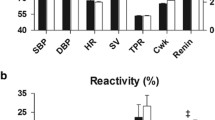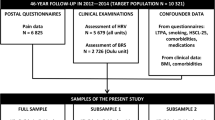Abstract
High resting blood pressure is associated with decreased pain sensitivity. This study was designed to explore this relation in young, normotensive men and women. Twenty-nine women (mean age 19.1, range 18-29) and 26 men (mean age 19.3, range 18-25) rested for 10 min while systolic, diastolic, and mean arterial blood pressures were measured. They were then asked to complete a 2-min cold pressor task. Participants were asked to fill out the short form of the McGill Pain Questionnaire immediately after the pain task. Hierarchical regression analyses were performed to predict pain sensitivity from resting blood pressure, gender, and the interaction of resting blood pressure and gender. Resting systolic blood pressure was a significant predictor of pain sensitivity. Gender and the interaction between resting blood pressure and gender were not related to pain sensitivity. This suggests that the relation between resting blood pressure and pain sensitivity may be similar in men and women, at least in response to a cold pressor challenge.
Similar content being viewed by others
References
AľAbsi, M., Buchanan, T., & Lovallo, W. R. (1996). Pain perception and cardiovascular responses in men with positive parental history for hypertension. Psychophysiology, 33, 655–661.
Bragdon, E. E., Light, K. C., Girdler, S. S., & Maixner, W. (1997). Blood pressure, gender, and parental hypertension are factors in baseline and poststress pain sensitivity in normotensive adults. International Journal of Behavioral Medicine, 4, 17–38.
Bruehl, S., Burns, J. W., & McCubbin, J. A. (1999). Altered cardiovascular/pain regulatory relationships in chronic pain. International Journal of Behavioral Medicine, 5, 63–85.
Bruehl, S., Carlson, C. R., & McCubbin, J. A. (1992). The relationship between pain sensitivity and blood pressure in normotensives. Pain, 48, 463–467.
Bruehl, S., McCubbin, J. A., & Harden, R. N. (1999). Altered pain regulatory systems in chronic pain. Neuroscience and Biobehavioral Reviews, 23, 877–890.
Ditto, B., Seguin, J. R., Boulerice, B., Pihl, R. O., & Tremblay, R. E. (1998). Risk for hypertension and pain sensitivity in adolescent boys. Health Psychology, 17, 249–254.
Dworkin, B. R., Filewich, R. J., Miller, N. E., Craigmyle, N., & Pickering, T. G. (1979). Baroreceptor activation reduces reactivity to noxious stimulation: Implications for hypertension. Science, 205, 1299–1301.
Elbert, T., Rockstroh, B., Lutzenberger, W., Kessler, M., Pietrowsky, R., & Birbaumer, N. (1988). Baroreceptor stimulation alters pain sensation depending on tonic blood pressure. Psychophysiology, 25, 25–29.
Fillingim, R. B., & Maixner, W. (1995). Gender differences in the responses to noxious stimuli. Pain Forum, 4, 209–221.
Fillingim, R. B., & Maixner, W. (1996). The influence of resting blood pressure and gender on pain responses. Psychosomatic Medicine, 58, 326–332.
Fillingim, R. B., Maixner, W., Bunting, S., & Silva, S. (1998). Resting blood pressure and thermal pain responses among females: Effects on pain unpleasantness but not pain intensity. International Journal of Psychophysiology, 30, 313–318.
Fillingim, R. B., Maixner, W., Girdler, S. S., Light, K. C., Harris, B., Sheps, S., & Mason, G. A. (1997). Ischemic but not thermal pain sensitivity varies across the menstrual cycle. Psychosomatic Medicine, 59, 512–520.
France, C. R., & Ditto, B. (1996). Risk for high blood pressure and decreased pain perception. Current Directions in Psychological Science, 5, 120–125.
France, C. R., Ditto, B.,& Adler, P. (1991). Pain sensitivityin offspring of hypertensives atrest and during baroreflex stimulation. Journal of Behavioral Medicine, 14, 513–525.
Ghione, S. (1996). Hypertension-associated hypalgesia: Evidence in experimental animals and humans, pathophysiological mechanisms, and potential clinical consequences. Hypertension, 28, 494–505.
Guasti, L., Cattaneo, R., Rinaldi, O., Rossi, M. G., Bianchi, L., Gaudio, G., Grandi, A.M., Gorini, G., & Venco, A. (1995). Twenty-four-hour noninvasive blood pressure monitoring and pain perception. Hypertension, 25, 1301–1305.
Maixner, W., Touw, K.B., Brody, M.J., Gebhart, G. F., & Long, J. P. (1982). Factors influencing the altered pain perception in the spontaneously hypertensive rat. Brain Research, 237, 137–145.
Melzack, R. (1987). The short form of the McGill Pain Questionnaire. Pain, 30, 191–197.
McCubbin, J. A., & Bruehl, S. (1994). Do endogenous opioids mediate the relationship between blood pressure and pain sensitivity in normotensives? Pain, 57, 63–67.
McCubbin, J. A., Kizer, J. S., & Lipton, M. A. (1984). Naltrexone prevents footshock-induced performance deficits in rats. Life Sciences, 34, 2057–2066.
McCubbin, J. A., Wilson, J. F., Bruehl, S., Brady, M., Clark, K., & Cort, E. (1991). Gender effects on blood pressure obtained during an on-campus screening. Psychosomatic Medicine, 53, 90–100.
Nyklicek, I., Vingerhoets, A. J., & Van Heck, G. L. (1996). Hypertension and objective and self-reported stressor exposure: A review. Journal of Psychosomatic Research, 40, 585–601.
Nyklicek, I., Vingerhoets, A. J., & Van Heck, G. L. (1999). Hypertension and pain sensitivity: Effects of gender and cardiovascular reactivity. Biological Psychology, 50, 127–142.
Pfleeger, M., Stravena, P. A., Fillingim, R. B., Maixner, W., & Girdler, S. S. (1997). Menstrual cycle, blood pressure and ischemic pain sensitivity in women: A preliminary investigation. International Journal of Psychophysiology, 27, 161–166.
Randich, A., & Maixner, W. (1981). Interactions between cardiovascular and pain regulatory systems. Neuroscience and Biobehavioral Reviews, 8, 343–367.
Riley, J. L., Robinson, M. E., Wise, E. A., Myers, C. D., & Fillingim, R. B. (1998). Sex differences inthe perception of noxious experimental stimuli: A meta-analysis. Pain, 74, 181–187.
Sheps, D. S., Bragdon, E. E., Gray, F., Ballenger, M., Usedom, J. E., & Maixner, W. (1992). Relation between systemic hypertension and pain perception. American Journal of Cardiology, 70, 3F-5F.
Sherman, J. J., Cordova, M. J., Wilson, J. F., & McCubbin, J. A. (1996). The effects of age, gender, and family historyonblood pressureof normotensive college students. Journal of Behavioral Medicine, 19, 563–575.
Stewart, K. M., & France, C. R. (1996). Resting systolic blood pressure, parental history of hypertension, and sensitivity to noxious stimuli. Pain, 68, 369–374.
Unruh, A. M. (1996). Gender variations in clinical pain experience. Pain, 65, 123–167.
Zamir, N., Simantov, R., & Segal, M. (1980). Pain sensitivity and opioid activity in genetically and experimentally hypertensive rats. Brain Research, 184, 299–310.
Zamir, N., & Shuber, E. (1980). Altered pain perception in hypertensive humans. Brain Research, 201, 471–474.
Author information
Authors and Affiliations
Corresponding author
Rights and permissions
About this article
Cite this article
Helfer, S.G., McCubbin, J.A. Does gender affect the relation between blood pressure and pain sensitivity?. Int. J. Behav. Med. 8, 220–229 (2001). https://doi.org/10.1207/S15327558IJBM0803_4
Issue Date:
DOI: https://doi.org/10.1207/S15327558IJBM0803_4




